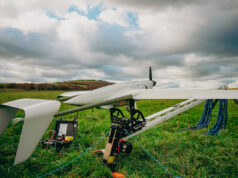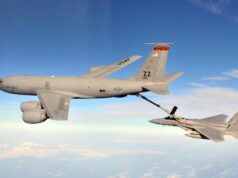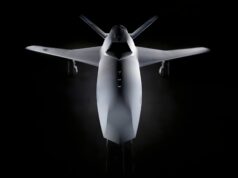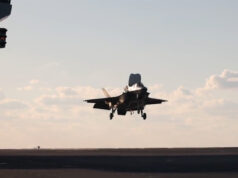Lockheed Martin is planning to significantly enhance the capabilities of its F-35 fighter jet, aiming to deliver what CEO Jim Taiclet calls a “fifth generation plus” standard—drawing on technology developed for the Next Generation Air Dominance (NGAD) programme.
Speaking during the Q1 2025 earnings call, Taiclet revealed: “The knowledge and technology development gained from our investments in the NGAD competition strengthened our conviction to enhance the F-35 to a fifth generation plus capability. And I challenged the team to deliver 80% of sixth gen capability at 50% of the cost.”
Despite losing out to Boeing in the recent F-47 air dominance platform selection, Lockheed is doubling down on its existing fighter platforms, aiming to keep them relevant through modular upgrades and integration of emerging technologies.
“This mission solution orientation that we call Twenty First Century Security is designed to extend the life and capabilities of our existing platforms like the F-16, F-35 and F-22 in an ever increasing threat environment,” said Taiclet. “We plan on applying those technologies to our current systems, making our already proven products even more relevant to the future.”
Dutch F-35s share classified data in first-of-kind NATO drill
Lockheed is already integrating NGAD-derived systems into the F-22 and F-35 fleets, including advanced infrared sensors and drone control autonomy features. In one notable milestone, Taiclet highlighted a breakthrough with the Royal Netherlands Air Force: “Our Skunk Works team joined with the Royal Netherlands Air Force to showcase the first ever live classified data share outside the United States between an F-35 in flight and a Dutch command and control system.”
With over 1,100 F-35s already delivered and more than 3,500 projected globally, Lockheed sees the aircraft as the digital “quarterback” of allied airpower. “The F-35 can execute its air combat quarterback role,” Taiclet said. “We’ve already shown the networking and teaming ability of the F-35 and the F-22 to control uncrewed vehicle systems like drone wingmen.”
The upgrades are part of a broader push to keep Lockheed systems competitive amid rapid defence innovation. “We have aligned these technology investments with our customer priorities and demonstrated meaningful increases in capabilities at relatively low cost,” Taiclet added.
Despite the setback on F-47, Lockheed’s message was clear: fifth-gen is evolving—and they plan to lead that evolution.














Whilst interesting (within US) other countries, including the UK presumably, will be looking at domestic production for almost all their defence equipment beyond what we have already committed to. We need to be sure we have a long term relationship with suppliers. Currently there seems to be a little uncertainty.
I think unlikely. There is a lot of posturing going on and a lot of politics but I suspect once the smoke settles and trump departs, business as usual will return.
Countries buy from the US mainly due to cost reasons, benefiting from economy of scales they gain from piggy backing onto larger US orders. Budgets are going up across Europe but not enough to compensate for the loss of that.
Trump is business as usual, perhaps at a faster pace than the dems would have liked, but the US has been shifting away from Europe since Obama as seen in 2014.
Biden didn’t meaningfully backtrack on Trump 1.0 or Obama and the next democrat will be the same. No stability in taking two steps forward and one back.
That said the cost will of course be a factor but one thing to consider is that the US’s low unit cost since the end of the cold war has in part been due to Europe buying US. Once that chain is broken the US will have to make up the difference itself to keep unit costs down and attract buyers. There could be a vicious spiral of US equipment becoming more expensive which pushes away more buyers, which makes equipment more expensive etc.
The Greek tragedy is that Americans may not realise how important its soft power hegemony is until it’s gone.
That is an excellent assessment, and one that Trump and his yes men simply don’t have the intellectual capacity to comprehend. We have recently seen clearly that any argument that Trump is a genius just acting the fool is delusional, he’s just a fool who is mentally in serious decline. Just watched a video on South Korea and it wanting to become the military supplier to the Western World it talks about supplying Canada a Battalion with full support of SPGs within months of an order a Regiment inside a year and at a price the US simply can’t compete with. It talks of supplying Canada with 7 submarines by the early thirties if they are serious. Their work with Poland shows they can deliver too. And all this is happening when even 5 years back it wasn’t taken seriously as an exporter. Japan too is breaking free from its political restrictions on arms sales and that could be equally dramatic once that barrier truly drops. Europe too is not standing still.
Fact is the days of US hegemony on arms sales was already under some pressure but recent events has made that decline a certainty only timing and scale is in question. Yes there may be some effect post Trump in that regard (assuming he leaves power) but the trend will remain because trust has been broken with a lot worse to come I fear and I think within a decade there will only be a limited selection of military capabilities where the US has a clear lead and virtually nothing where it has a financial advantage. Space will probably be the last bastion but even there Japan, India. Europe and others are finally getting their act together and non American solutions or options like Rocket Lab who have wider National interests will only grow.
The US is already struggling with military costs which is why it thought it could enforce outsiders to finance much of it, I suspect the opposite will be true.
We are already committed to at least the B model for the carriers. No doubt whatever upgrades get cooked up for it over time will be applied, be those American or domestic.
Indeed, LM and its suppliers mind have hardly excelled in providing what was promised with the F-35 certainly in time and reliability considerations so it will need to work very hard to gain the trust of its customers especially in an environment where its capability exclusivity is going to decline by decade’s end. Obviously it has to make the best of a defeat in NGAD but what substance it has in reality is going to be the real test. It will be interesting to see how effective and reliable South Korean and Turkish 5th Gen aircraft become by decade end not only in terms of how competitive they become but the prospect for new competitors in the mindset of potential customers should these aircraft meet standards in reliability, upgradability, adaptation and weaponry or other areas as a later generation platform, that the F-35 struggles to meet and which will suggest major efforts like Tempest are likely to attain or exceed too.
‘ … little uncertainty …’
That is being very diplomatic, Mark. We didn’t even get a warning.
If ancient F-16s are holding their own in Ukraine, why not just upgrade Typhoon taken under our national sovereignty interest?
This would be very interesting in regards to the carriers..
The planned out of service date of the carriers is around 2069.. but I could see that extending by a number of years.. meaning the F35b could still be flying off UK Carriers in 50 years so having a fifth generation+ mid life face lift keep it relevant in the 2050s would be useful.
I doubt it. Technology is moving too fast. The F35 will be obsolete quite quickly in my humble opinion. Just not yet ….
The Stringbag was deemed obsolete even though it was a new design/build, still did a cracking job though.
“On a wing and a prayer”.
Also the nexus of F35 design was essentially late 1990s early 00s ideas and concepts so at least 20 years dated as the process has been so glacial.
Whilst the electronics can definitely be updated the architecture probably can’t.
The other issue is the turgid delivery of the existing upgrade cycle – I wouldn’t bank on this happening fast.
Since the F-35 is an American programme others have been permitted to buy at a price, there is no impetus to allow others to integrate their own systems at any time – the ‘it will take six years’ monopoly that keeps Meteor, to take one example, off the platform for good.
Not really if you look at the vast majority of jets in the world they now stay current for a very very long time..look at the f15 it’s 53 years old and still being manufactured…it will be manufactured well into the mid 2035s and not out of service with modern western nations until maybe 2060…almost 100 years after it first flew… second world militaries will probably be be flying it into its century…
Yes it’s speeding up but it’s also slowing down.
In regards to fighter jets, the tech I’m not sure the tech is moving forward. Stealth was first introduced in the 80s. Outside that not a lot has changed in the air frames themselves, incremental changes, but nothing that would materially win /lose a fight. The big changes are mainly from better sensors and missiles, but both of them can be bolted on to older platforms if required.
The only question mark on that is if stealth turns out to be not as effective as sold, or gets beaten, at which point larger planes fitted with longer range stand off missiles will be needed. The issue with that, is I don’t see how it would work with a short take off and landing carrier, as the extra weight would cause problems.
I suspect in the days of beyond visual range missiles and jets not having guns, the ability for the plane to turn faster etc is mainly redundant as a missile will always be able to do it faster due to less mass and there less momentum.
Stealth has moved in a lot from the 1980’s approach.
Lots of new and specific materials have been developed or co-opted into manufacturing.
Also better manufacturing methods have lead to improvements in aspects.
I hope the government is aware that only the marketing department of Lockheed Martin can define a 6th generation jet.
The F47 along with Tempest will now only be a 5.5 gen aircraft 😀
In all seriousness it seems the USAF did the sensible thing and choose a less capable concept than what LM was offering. Very much how LM beat Northrop with the YF23 and YF22 competition.
HMG will watch with interest what comes out of LM. The question is will it buy any of it and do they care what LM market stuff as. The current Government seem quite keen to produce kit in the UK – let’s hope it is excellent kit.
I have great confidence in Tempest – it has the right mix of countries involved who have the relevant tech.
What it’s missing is funding. Not sure combined that the current list of countries will buy enough platforms to make it economical. For example I can see the UK buying sub 50 and same with Italy. Maybe Sweden and Japan might buy a few more but it’s going to go no where nearly as close as the original typhoon planned numbers or the final orders by member countries.
Both UK and Italy will be looking for at least 100. Japan may go further…
But the funding is there…and the UK has the largest defence budget of the 3…
Hope this means sorting out all the TR3 software/hardware delays first in the current versions so that that doesn’t get repeated?
Indeed. Would be nice to get 5thgen issues resolved first.
TR-3 mod is now a reality, pending final software release. Block 4? Ummm…er…perhaps a consultation w/ the Oracle of Dephi would be in order…🙄🤞🤞
Hope I may repeat comment from the Royal Navy rebuttal of Proud’s article as it has relevance to this debate.
Wonderful article George. Because of my schedule I often come late to the debate when it is pretty much commented out! My only chirp to add is my agreement with the comment that shipbuilding times for the RN are beyond glacial and make no sense. OK one cannot expect to match Spitfires and destroyers delivered in days and weeks in the modern era, but from cutting first steel to operational service times approaching a decade, make no sense.With the lightning pace of modern tech innovation there is a very real possibility of ships becoming obsolete before they raise the White Ensign!! Surely the number one priority should be to speed up in service targets for ships and planes?
I suspect a large part of prior timelines was driven by funding tranche releases …
Slow drumbeat of cash, mixed with bespoke engineering.
Frigate factories should facilitate consistent delivery performance….provided key skills are retained.
Also making sure the shipyards had workflow over lifecycles.
Build faster is cheaper in the long run if you can sweat the cash flow.
Hi SB-yes realise that retention of skills and providing constant turnover is really critical. A much more complex problem than when seen superficially. Text book economics from simple operations tell us that the bigger the numbers built the lower the overhead unit cost when maximising any production setup until you get to the point when you need a new factory! Also as Pete says-bespoke engineering is a big problem-effectively the bloated costs associated with small numbers. What about trying to build a basic shell to accomodate most of your needs and allow the fitted for but not with to dictate individual requirements?
Thanks Pete but then in simplistic terms surely funding must be accelerated
Is that up dates for every one or just the USA and will they limit or control these up dates like do with every thing else. Expensive but safer to buy in Europe and not get ripped of with up grades as when the maker feels like you can have them.
This isn’t primarily a US/Europe thing. It’s a Lockheed/Boeing thing. At least so far. Lockheed, having lost the NGAD funding stream, are looking to get more money by adding tech upgrades to the F-35 and F-22.
Whether those upgrades happen depends on whether the US is prepared to pay their share for them. That in turn probably depends on whether the USAF lobbies for them. If the US are willing, we’ll have to pay our share as well. If not we won’t even be offered the choice.
Jon,
Yes, if there is one skill LM, and indeed the US MIC as an entity have perfected, it is surely the capability to pass the collection plate for donations.
Yeah right, when they still can’t even manage to get current gen weapons integrated.
Hopefully this will have a “no dessert till you finish your veg” effect and LM will finish what’s Infront of them so they don’t get left behind.
Maybe a naive point but one I’ll raise all the same. Nowadays anything that is computer based will probably see most of it’s development in its software and firmware. Maybe some hardware modernisation may be necessary, in the form of the ‘windows’ the sensor suite needs to see improvement in (materials for greater resolution for example) ….. maybe another engine upgrade after the current slated upgrade. So, is there any reason why an F35 might ever become obsolete? Of course fatigue will play a roll, so is this where the 138 F35s come into play the UK said they would originally order? I dare say there are capabilities we can only imagine, or might not yet have dreamt up, that might render the current airframe design obsolete but is it foreseeable the current design could just ‘soldier on’?
We, the U.K. – will still be tied hand and foot to an American decision making process and production timetable. As the late great Freddie Laker once said ‘In America it is not ‘do as I do’ but ‘do as I say’. I don’t blame them. So, why not spend the money here and upgrade Typhoon? Putin’s much vaunted) air force not doing so well I understand.
Yes, it’s a fair point. The US are upgrading their F15s from F15E to F15EX, which modernises their electronics suite whilst adding further weapons fit for operations day-2 onwards. So they see a need, not just for cutting-edge systems like F35 and NGAD but for modernised legacy systems that will continue to provide an effective offensive to their adversaries. If the UK had the budget, I’d like to see us expand the no. of Typhoons with ECRS Mk2, or, better still, Tranche 5 Typhoons. It would help keep production lines and skillsets active here in the UK and, should the timelines for Meteor and Spear 3 integration continue to slide to the right, allow us to use a capability our F35s can’t at the moment.
If Jim Taiclet wants to upgrade the capabilities of F35s, he should direct his workforce to expedite the integration of NATO weaponry onto the existing aircraft.
We are supposedly keeping our F35s until 2070, which seems like a long time. By 2070 Tempest could have been in service for over 20 years!
Blk 4 will enable many of these capabilities. Which is why it’s such a complex piece of work. For many nations, F35 will be the 6th gen option. Or 5th gen +. Any new 6th gen platforms will likely only built in small numbers. So F35 will be around for many decades to come.